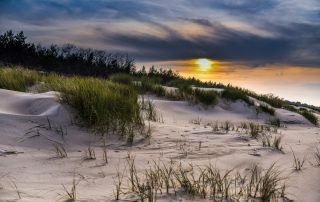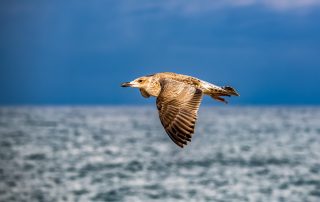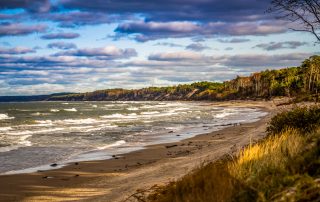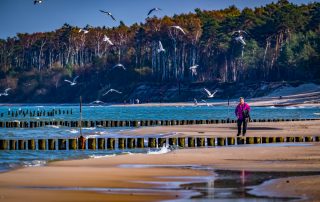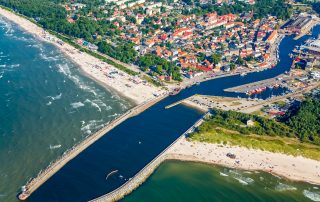NATURE IN USTKA
ABOUT NATURE IN USTKA
Ustka
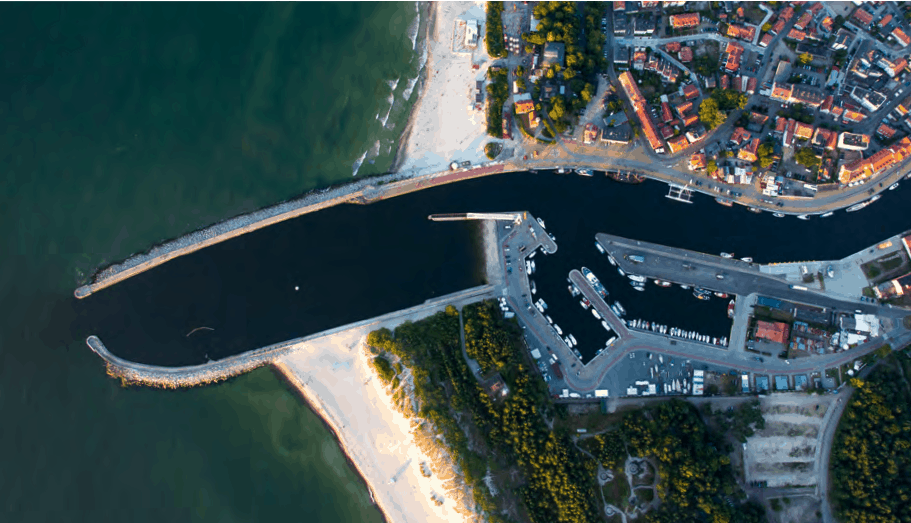
Ustka can boast an exceptional location. It cannot be said about any other city in Poland, that it is located by the sea, amongst high hills, in a unique river valley and in the vicinity of a pond… haunted by ghosts. Each of these places is a separate natural universe. They can easily be accessed by taking a pleasant stroll around the city and the surrounding area. The woods and coastal forests form a kingdom of bent pines and intensely green undergrowth. The dunes bordering the beach are overgrown with the hardiest grasses, and on the beach, you can come across isolated clusters of nitrophilous strandline vegetation (organic debris washed up by the waves on the seashore). Słupia Valley is adorned with a beautiful beech forest. Magnificent trees, natural monuments also grow by the very coastal promenade.
TRAILS
Uroczysko Trail (green)


If you are looking to inhale the miraculous pine essential oils, you should take a trip along the Uroczysko Trail. It runs along a coastal landscape, stretching on the western side of Ustka; between the beach and residential buildings. At times, the trail leads along paved alleys, thereby giving the area a pleasant forest and park character. During the stroll, you can admire countless steep hills, however, the trail runs mainly at their foot. There are modern markings on the route (directional sign posts, map boards). There are also rest points. It is worth noting that delineation of trails did not involve cutting of any trees. Uroczysko Trail begins on the west side of the revolving footbridge, which runs in the port on Słupia (be sure to the opening hours on the information board when crossing). This place also marks the beginning of several other routes. While following the black trail leading along the river (port canal), after a while we make a turn right. We pass the Blücher Bunkers and head southwest, walking through the forest along the western beach. However, there is no beach along the entire trail.
If you are feeling like walking on sand, you can use one of the several descends. After a few minutes of walking, the path turns left and leads us to the Bohaterów Westerplatte Street. The street is only a name: we are on a paved forest road, which bifurcates at this point: the right branch (road sign “dead end”) leads towards the car park at the Third Pier, while the left one runs to the “Uroczysko” Holiday Resort. If you are feeling like taking a shortcut, you can go left – the trail has been marked in such a way that a short walk will lead to its last section, headed to the canoe harbor on the Słupia River. We are choosing the right branch, and it takes us several minutes to reach the car park at the Third Pier. There is a modern gym, a map of the trail, a resting place and a small catering outlet. The beach and the Third Pier can be reached via a convenient sidewalk. Meanwhile, the Uroczysko Trail leads further south-west. After covering the half-kilometer distance, the trail splits again and there is a resting place. Not much later, our route turns gently left, duplicating the course of the travelled road. After another several hundred meters, it connects with Uroczysko Street and runs southeast for a few minutes. Then the route turns left into the path leading to the Ghost Pond. After several minutes of walking, we reach the Ghost Pond, which is also an ecological site appointed by way of Resolution No. XIII/135/2019 of October 29, 2019 on the establishment of the ecological ground “Seekenmoore Pond – Ghost Pond”. It’s a great place to rest, equipped with the appropriate infrastructure. There is even a covered porch where you can hide from the rain. Around the reservoir there runs a path, partly leading along wooden platforms. Behind the pond, the trail turns left, leading to the “Uroczysko” Resort, then it goes right into the street. About a kilometer further we reach the railway tracks. Here, the trail turns left, along the railway line. The last part of the hike follows through the urban areas. We reach Słupia, then – without setting foot across the river – we walk along the shore to the canoe harbor. Here the Uroczysko Trail finishes.
Beech upon Słupia Trail (orange)


On the southern outskirts of Ustka lies the only nature reserve within the city: Beech upon Słupia. The trail marked out here bears the same name. It is worth setting foot on it to admire a variety of natural ecosystems grouped in a relatively small area. There are oak-hornbeam forests, alder forests, riparian forests and various types of beech forests. These beautiful, monumental and ornamental trees are sometimes called “forest cathedrals”. The trail is somewhat wilder than Uroczysko – it leads through less accessible areas of the nature reserve. The tourist infrastructure has been adapted to it: it is deliberate action that there are fewer devices here so as not to disturb the contact with nature. The route starts at the railway tracks, between the river and National Road no. 21 to Słupsk (the route is circular, so you can start your trip anywhere else). We cross the tracks and turn left along them. The yellow Słupia Valley Trail and the red Baltic Coastal Trail (a fragment of the E9 European long-distance path) also lead here. They are accompanied by the Pomeranian Way of St. James, marked with a characteristic shell on a blue background. All three routes lead here from the center of Ustka, and we will be moving on a path common for them in the reserve. The road goes south-east through the forest, parallel to the railway line. Having walked about 500 meters, we see the meander of Słupia on the right. We are in a superb location, at the top of a steep embankment. Its existence is due to the activity of only water. The river makes a sudden turn, and shortens the right bank, causing erosion. The difference in levels between the Słupia bed and the upper part of the valley can reach even 12 meters in some areas. At about this point, the trail splits from the railroad tracks, turns south, and then south-east again. When traversing the trail, we move through a rugged terrain, passing a beech¬-oak-hornbeam forest. Another encounter with the river takes place half a kilometer away. Its shores are connected here with a high pedestrian bridge, which you can cross to reach the village of Wodnica. The stairs leading to the bridge are additionally equipped with special rails, so that cyclists can also easily cross to the other side of the river. At the bridge, we say farewell to the other routes that lead to the other side of the river. We are making a turn left and going deeper into the reserve’s forest wildernesses. Our attention is drawn to street lamps placed along the narrow path. We are now heading east, towards the Mokrzyca train stop. The trail runs to the railroad tracks, about 100 meters from the stop. Next, it turns left, then right and leads us to the outskirts of a detached housing estate. Here we make a slight turn left, entering the so-called Grabieński Forest. It differs in nature from the forest in the reserve – there are pines here on the less fertile ground. The path leading through the Grabienski Forest leads to the output point, thus closing the loop of the Buczyna upon Słupia Trail.
NATURE TRAILS
“Water Ecosystem” Nature Trail

Both the easiest and the shortest of all six nature trails in Ustka. It can be crossed by people of all ages, including those with limited physical strength. Its total length is about a kilometer and it runs across a flat terrain, mainly along the railway tracks. Over the pond there are information boards, shelters and small benches on which you can sit. The route starts at the end of Kościelniaka Street, next to a residential complex (motorists can leave their car here in the parking lot). The street ends at the railroad tracks, which you must cross to the other side and turn left. The path follows the recently renovated railway platform. After about 300 meters, turn right and follow a comfortable walking path to the Ghost Pond. The trail runs adjacent to body of water, partly along a wooden pier (from the railway tracks). Alongside the pond, it is worth taking a closer look at its surroundings: impressive steep hills rise from the northern side. After rounding the Ghost Pond, the trail comes back by the same way, along the railway line, to the starting point.
“Promenade” Nature Trail


One of the longest hiking routes in the city. It runs along the Seaside Promenade, which is a favorite walking route of holidaymakers. It follows through a varied, undulating terrain: partly along streets, in part through forest and dunes, and also in the vicinity of resort centers. There are several relatively small climbs along the way. The trail provides a channel to discover four natural monuments in Ustka. The path starts at the Harbor Master’s Office, from where it heads north towards the eastern breakwater. The opportunity should also be taken to visit the Mermaid in Ustka and wave hello to your friends in the webcam installed here. East of the breakwater, the path enters the beach. It then climbs the promenade, where it initially leads along the lower route (Limanowskiego Street). After a moment we come up to the first tree: the white poplar, also known as the “Trident of Neptune” due to its distinctive shape. The street continues east to another nature monument. This time it is the common beech called the “Rays of Helios”. Behind it, we turn left, towards the higher part of the promenade (we pass the unmistakable silhouette of Villa Red). Along the upper promenade we walk along the beach, admiring the Chopin Park on the right. About 200 meters further east, on the promenade itself there stands another monument-tree: the sycamore maple “Gwido”. Admirers of historic trees can take the path into the park and after a while turn right into the first alley. It leads to the fourth natural monument: the European ash “Zeus”. By the way, we can see the famous monument of the “Dying Warrior”. Further east, the Seaside Promenade reaches the larger Health Resort Park. It borders on the Solidarity route from the other side. Here ends the main part of the promenade, and the further walking route leads through undulating terrain a little further from the beach. It’s the so-called New Promenade which, thanks to the paved surface and lighting, can also be set foot upon in after dark. It climbs the so-called “Scouting Hillock”, on the left side passing the viewpoint on the highest cliff within the boundaries of the town. After a few minutes of walking, at the height of the extension of Rybacka Street, we can take a closer look at information boards. A few hundred meters further east marks the finish of concrete cubes. Here the path turns south, leading along a dirt forest road to Wczasowa Street. We turn onto the last street, embarking on our return to the city center. Wczasowa Street leads to the Wlokniarz Recreation and Rehabilitation Center. Behind it, the trail turns into a path with scattered small stones. At the crossroads, we turn right at right angles, towards the sea. There is one more environmentally interesting episode ahead of us. We arrive at a dune, where we turn west, to the wooden pier leading along it. This exposed area is commonly known as the “pan” – it can get very hot in summer. The next stage of the trip is the Solidarity route, where we turn north and reach the playground. We are at the Health Resort Park again. At the square, the trail turns left, into a path made of concrete paving blocks, through which we cross to the other side of the park. The final stage of the path is all about a stroll along the streets: Leśna, Chopina, Beniowski and Zaruski. The latter leads to the port where the Harbor Master’s Office is located. In this way we have come full circle. The path starts near the bridge over Słupia, on its western shore. We move along the river towards the south-east. The hike is quite short and ends after a few hundred meters at Stanica Kajakowa. Be sure to walk along the pier with caution, as there are no handrails (they would disturb the canoeists). It is planned to extend the path by a section running along the other river side – it is to be set up after the construction of a footbridge for pedestrians and cyclists.
“Along the Riverside” Nature Trail

This short route will allow you to make a tour around the area slightly far from the coast. Still, there is an abundance of water here – we will move along the invaluable natural riverbed of Słupia. Within the limits of the route, we have a paved runway under our feet (pavement, asphalt and ground prepared especially for pedestrian and bicycle traffic). The path starts near the bridge over Słupia, on its western shore. We move along the river towards the south-east. The route is quite short and ends several hundred meters at Stanica Kajakowa. Be sure to walk along the pier with caution, as there are no handrails (they would disturb the canoeists). It is planned to extend the path by a section running along the other river side – it is to be set up after the construction of a footbridge for pedestrians and cyclists.
“Sea and Shore” Nature Trail

It’s a tremendous route for those looking to inhale iodine and get their breath back after fatigue with the hustle and bustle of the eastern beach (western beach is much calmer). Its first part runs along the beach itself, and the second part traverses the coastal forests. The surface is very varied – from sand and dirt path to sections paved with concrete blocks. The starting point is a mobile footbridge in the Ustka port. The initial section runs on the left side of the western breakwater, leading us to the beach. We walk along it west for less than a kilometer. On the horizon emerges the characteristic silhouette of the Third Pier which overlooks the sea – we can reach it, but using a circular road. Within a several minutes’ walk, we leave the beach along the descent, where we can read several information boards. There are trenches in the area – the remains of the times when the area belonged to military authorities. The path leads to a paved road, which is an extension of Bohaterów Westerplatte Street. We come to its end – there is a parking lot and a resting point. The trail turns right into a convenient pedestrian and bicycle route leading to the beach at the Third Pier (a few minutes’ walk). The best journey back runs along the beach. The section between the Third Pier and the western breakwater is a half-hour walk (1.3 km).
“Reserve” Nature Trail

This walk will let you visit the only nature reserve within Ustka – “Buczyna upon Słupia”. The path is led away from the sea, south of the city development. It runs along dirt roads with wetland here and there (especially during the high-water period in Słupia). The trail starts in the city at Wileńskie Roundabout, from which we exit through Ogrodowa Street. Before the railway tracks, we turn left onto a forest road. We go south-east and then south. At the crossroads, we make a turn right and cross the nearby railway tracks, then turn left into the path along the embankment. Half a kilometer further on the right we pass Słupia – we are on a high bank with a marvelous view of the river. Our route leaves the railroad tracks and plunges into the reserve, along with several other routes (this is the only route available to tourists in this area). After another 500 meters of hiking, we are back by the river. There is a pedestrian bridge here, but we don’t cross it. Instead, we turn left into a narrow path leading to the Mokrzyca train stop. The substrate is usually damp here. Behind the tracks, after a dozen or so minutes’ walk, we approach a new detached housing estate. We turn left, entering the so-called Grabieński Forest. We follow the forest path to where we had crossed the railway tracks for the first time: this way, we have made a full circle. We walk along another forest road, and then through Ogrodowa Street we return to the Wileńskie Roundabout.
“Healing Ether” Nature Trail

The route is arranged in a small loop and leads mainly through forest areas south of Wczasowa Street. Thanks to the reinforced surfaces and low elevations, it is easy to cross. One of the greatest attractions of the path is a fragment of an exposed dune. It is best to start the journey at the Sports and Recreation Center, from where we exit to Rybacka Street and head north-east. After a few hundred meters we reach a sharp turn of Rybacka Street towards the sea. We turn slightly right into the path leading to the exposed dune. We make a few turns right, while still having the dune on our right side. Part of the route runs along a comfortable pier, there is also a viewing point with a bench in the vicinity. Behind it, the path leads east, and when the road ends, we make a sharp turn right. Shortly after we reach a dirt forest path leading straight west towards the starting point of our trip.
PLANET LIFE
Plant life

In botanical terms, Ustka and its surroundings are a veritable treasury of nature. Owing to the localization of the city both by the sea and in a river valley, the flora is exceptionally rich here. There is a different type of flora on the beaches (contrary to appearances, life exists here as well), and another kind on the subsequent stretches of dunes: white, gray and brown (usually wooded), and yet another – in the fertile and wet valley of Słupia. Valuable for environmental reasons are also the parks at the heart of the city by the Seaside Promenade.
Beaches

Baltic beaches are not just about sand. In some places there are isolated clusters of vegetation, with underlying organic material discarded washed up on the beach. These are mainly the remains of seaweed, and sometimes debris of jellyfish and fish known as nitrophilous strandline vegetation. They usually take the form of elongated dikes or clusters located in humid locations at the foot of the dunes. They are characterized by exceptional impermanence – entire clusters of nitrophilous strandline vegetation can be sometimes removed even during. . . cleaning of beaches. For that reason, there is usually annual vegetation here (with a tendency to yearly regeneration patterns). It is halophilic and nitrophilic, i.e. it likes very salty or nitrogen-packed soil. Species that favor living in such an environment include European searocket (Cakile maritima) and corn mayweed (Matricaria maritima).
Stripe of Dunes

The sand dunes, formed as a result of the accumulative activity of the sea and wind, stretch between the beach and the seaside pine forest. In environmental terms, they are divided into white and gray dunes. White dunes are a very unstable ecosystem made up of sand elevations subject to winds blowing from the sea. Such extreme conditions allow for survival of only the most resistant plants, mainly deeply rooted grasses. These include beach grass (Ammophila arenaria) as well as lime-grass (Leymus arenarius) and purple marram (Calammophila baltica). In slightly more peaceful places, less buried by sand, there are fescue (Festuca villosa), sea pea (Lathyrus japonicus) and sand sedge (Carex arenaria). Ocassionally there is also sea holly (Eryngium maritimum). The western beach of Ustka is a great point for observing white dunes. There is also the so-called embryo stage of coastal white dunes, or a rather undistinguished habitat between the beach and the white dune: it is no longer a beach, but still not a dune. As a natural environment, this area is very unsteady: it can either be buried by sand or swallowed up by the sea during a storm. Sea sandwort (Honckenya peploides), European rocket (Cakile maritima) and couch grass (Agropyron junceum) grow here. You can also see here the abovementioned beach grass and lyme grass. The most common kind on the Polish coast is the gray dune (it covers 70% of its length). Dune width may vary from a few to over a hundred meters. It is overgrown with weak and unstable grasslands, which develop only in places that are unlikely to be buried in sand. Depending on factors like soil moisture and fertility, the gray dune is divided into two types: lichen and herbaceous. The first has a dominance of the lichen and moss layer, while the second is more typical, with a grass layer. Both are covered with plants such as: narrowleaf hawkweed (Hieracium umbellatum), wild pansy (Viola tricolor subsp. maritima), field wormwood (Artemisia campestris subsp. sericea), Dark Red Helleborine (Epipactis atrorubens). There are also lichens: Cetraria muricata and several species of cladonia. The nature of the habitat makes it exceptionally sensitive to mechanical deterioration, including trampling (it is prohibited to walk on dunes).
The Coastal Forest


Coastal forests form one of the most representative and optically very attractive ecosystems in the Polish natural spectrum. The vast majority are spatial, fulgent forests dominated by pine. Things are no different here in Ustka. Dunes comprise a terrain particularly sparing in nutritional terms. They were created as a result of centuries-old deposition of sand blown by north-west winds. The coastal forest covers a narrow stripe of the coast directly adjacent to the beach and the younger dunes where only the hardiest vegetation grows. It’s a very peculiar place: it remains in the immediate area of impact of the harsh marine climate. Coniferous forests in the vicinity of Ustka are considered as one of the best preserved on the Polish Baltic coast – naturalists compare them to those on the Hel Peninsula and in the Słowiński National Park. The local tree stand is mainly pine monoculture (Scots pine; pinus silvestris). The pines growing here have a very characteristic habit, and their height usually does not normally exceed 15 meters. Owing to the winds blowing from the sea, the trunks of many trees are heavily bent, the branches are twisted and the crowns are asymmetrical. For that reason, their wood has never had great economic significance, such as in inland forests. Only here and there can one find individual specimens of the common birch (Betula pendula). In depressions and in more humid areas, there are: moor birch (Betula pubescens), Canadian oak (Quercus robur) and European beech (Fagus sylvatica). The intensely green undergrowth is usually mossy and overgrown with plants such as: Glittering Wood-moss (Hylocomium splendens), red-stemmed feathermoss (Pleurozium schreberi, Pseudoscleropodium purum) and dicranum. The usual species that grow in the shade of pine trees include: black crowberry (Empetrum nigrum), sand sedge (Carex arenaria), dwarf rattlesnake plantain (Goodyera repens) and St. Olaf’s Candlestick (Moneses uniflora). The former is a pretty heathery shrub with partially trailing shoots, which grows only up to 20-30 cm, thanks to which it is resistant to sea winds. It is so prevalent here, that the forests growing in the dunes are called coastal crowberry forests. Accompanying it are also other shrubs, such as: common heather (Calluna vulgaris), bilberry (Vaccinium myrtillus), cowberry (Vaccinium vitis-idaea), heather-bell (Erica tetralix), or wavy hair-grass (Deschampsia flexuosa). There are also the classic coniferous species: chickweed-wintergreen (Trientalis europaea) and common cow-wheat (Melampyrum pratense). In the driest habitats, there is an abundance of the lichen genus Cladonia. In humid depressions, you can come across marsh tea (Rhododendron tomentosum) and bog bilberry (Vaccinium uliginosum). There are also shrubs in younger pine complexes, including mountain ash (rowan; Sorbus aucuparia) and the creeping willow (salx repens). The latter is a remnant of an earlier stage of dune overgrowing (it was formed there before the pines).
Buczyna upon Słupia

The Buczyna upon Słupia Reserve extends from the Słupia Proglacial Stream Valley (18.82 ha) and is located a few kilometers south of the city center. It is situated between the meandering riverbed and the Słupsk–Ustka railway line. It was established in 1987 to protect the hundred-year-old beech forest, one of the last remaining primeval forest complexes of this kind in Pomerania. Apart from beech trees, you may occasionally find numerous other valuable botanical specimens, including those listed in the Red List of Threatened Species. Fortunately, the habitat will have the opportunity to self-regenerate in the future – as evidenced by the presence of the common beech (both in the layer of trees and shrubs). The lowland beech, also known as the sweet-scented bedstraw, is one of the most distinctive landscape features of this part of the country. The territory is characterized by a relatively rich undergrowth and a uniform forest stand, with small additions of other species, such as: durmast oak, European hornbeam or elm. Striding through the reserve, we will also come across forest communities typical of wetlands. Central European alder, as well as an elm and oak riparian forest and a beech-oak-hornbeam forest grow here. The landscape is complemented by herbaceous plants, including intermediate corydalises, Broad-leaved Helleborine (Epipactis helleborine Crantz), the Belgian Gagea (Gagea spathacea (Hayne) Salisb.), Common ivy (Hedera helix), Lily of the valley (Convallaria majalis) wood melick (Melica uniflora), woodruff (Galium odoratum) and river water-crowfoot (Ranunculus fluitans). In the swamps, covering approximately 13% of the reserve, there are high and low rushes typical of this environment. There are: reed sweet-grass (Glyceria aquatica), common reed (Phragmitetum australis) and reed canary grass (Phalaris arundinacea) and the impressive yellow iris (Iris pseudacorus).
Nutritious and Acidic

The Pomeranian fertile forests Galio odorati-Fagetum are dominated by beech and covered with moraines with a fairly rich substrate. They are usually recognized by the composition of groundcover. Nonetheless, the plants that grow therein are not always present in full composition (and there are also fertile beech forests with a completely bare forest cover). This type of ecosystem is stable in our climatic conditions and can develop without any human intervention. Acidic beech forests occupy areas with a poor nutritional setting. They prefer highly acidic soils, i.e. light loams and argillaceous sand with varying humidity. Sometimes it is difficult to distinguish them from fertile beech forests, especially in places with shady ground. The “acidity” of beech trees is evidenced by “cushions” of moss at collar level of trees (the part of the trunk at ground level). The stand of acidic beech trees is usually made up of only beeches, but there are also admixtures of other trees.
Wet, Wet, Dry

At the Buczyna upon Słupia Reserve, there are various forms of forests, including alder, riparian and hornbeam forests.
- Ols (also known as oles or alder), commonly known as a forest on islets, is an inaccessible complex overgrowing stagnant or slowly flowing waters, in which the mirror level ranges from a few to several centimeters. The dominant species is black alder (Alnus glutinosa), sometimes accompanied by warty birch (Betula pendula) and elm (Ulmus). Alder forests grow on a peat substrate, surrounded by rush plants. Sometimes, when the water level drops permanently, there is a so-called riverization of alders, i.e. their transformation into riverine communities.
- Water meadows usually develop in river valleys and other periodically flooded areas, which are characterized by large fluctuations in water levels. The stand includes elm, oak, ash, alder, poplar and willow. Water meadows cut off from the activity of water and periodical swamping may take on riparian and oak-hornbeam features or be transformed into oak-hornbeam forests.
- The hornbeam forest is one with a sparse undergrowth, usually growing on the slopes of valleys of small and medium-sized rivers. It appears on various soils, including brown, podzolic, acidic and glial (in the coastal zone).
The typical composition of the sub-Atlantic oak-hornbeam forest stand is beech (Fagus), English oak (Quercus robur) and hornbeam (Carpinus).
Słupia Valley

Between the nature reserve and the center of Ustka, Słupia flows through meadows with a rich floral composition. In the coastal zone, there are communities of marsh plants in the form of rushes. There are, among others Great Manna Grass, reed rush and Phalaridetum arundinaceae. A valuable plant is the river buttercup, also known as the river water-crowfoot (Ranunculus fluitans). Since 2014, it has been under partial protection in Poland. This beautiful perennial blooms from June to August. The petals of its crown are white, the flower bottom is yellow, and the stem is 6 meters long.
Ecological Ground “Pond Seekenmoore – Ghost Pond”

A botanical point of interesting Ustka is Lake Seekenmoor (The Ghost Pond), located in the western part of the city – between the railway tracks and a beautiful pine forest. It covers an area of 0.32 ha and is a freshwater septic tank fed by one small watercourse. Among the local flora, it is worth mentioning aquatic plants, such as: white water lily (Nymphaea alba), red-stemmed feathermoss (Pleurozium schreberi), blunt-leaved bogmoss (Sphagnum palustre), spiky bog-moss and Cladonia arbuscula. The shores of the lake are overgrown with rushes, water cannons and marsh horsetail. In the neighboring forest, it is easy to find shrublets of lingonberry and bilberry.
Water Hemlock by the Pond
The poisonous properties of water hemlock, the herb of assassins, is known to everyone, but not all are aware that this plant is the popular cowbane (Cicuta virosa L.), growing on wetlands, also in Poland. It has a very innocent appearance: its leaves smell like parsley, the roots resemble celery or turnips and have a slightly sweet taste. In ancient times, water hemlock was used to carry out death sentences (the condemned had to drink a dose of poison). It was also willingly used for discreet elimination of enemies or political opponents. In 399 B.C.E. the famous Greek philosopher Socrates died after being poisoned (some historians believe that he was given a brew of an equally toxic poison hemlock (Conium maculatum). Symptoms of poisoning include convulsions with trismus and severe psychomotor agitation (unintentional and uncontrolled). Hence the origin of the popular saying “to eat one’s fill in cowbane” to describe the behavior of an insane person.
NATURE MONUMENTS
Nature monuments

Man has always lived surrounded by trees. They were not only of economic and medicinal importance, but were also objects of worship and a center of magic. Many cultures would plant a tree for a newborn child – it became the spiritual brother of the newborn. Human habitations would be surrounded by planted trees which also gave shelter to travelers. Today, in the era of civilization development and progressive anthropopressure, the protection of these symbols of longevity and silent witnesses to history is of exceptional importance. Therefore, the initiative of students of the ecological class of the now defunct Mariusz Zaruski Junior High School has led to the establishment of four natural monuments in Ustka; they are presented below.
The Trident of Neptune

This impressive white poplar (white aspen; Populus alba) stands at the bottom of the promenade, the closest to the port of all four monumental trees (at Limanowskiego Street, between Bieniowskiego and Słowiańska streets). It rises to 16 meters, with a trunk circumference of 270 cm and a crown span of 22 meters. Its straight trunk, forked into three massive boughs, resembles an attribute of power of the Roman god of waters, clouds and rain – Neptune. The white poplar lives for about one hundred years and reaches a height of up to 28 meters. Dust settles very well on dark green leaves, which is why it was so eagerly planted along roads. It blooms from March to April, covering with characteristic catkins. These poplar flower clusters come in two forms: male and female. The fruit of the tree is a bag that contains tiny seeds covered with hairs (the clusters of seeds resemble cotton during the pollen season). Poplar wood is soft and light. It is used in the production of matches, pencils, crayons and musical instruments.
INTERESTING FACTS
The white poplar is ubiquitous in Greek mythology. Hades turned the nymph Leuke into a poplar after her death and placed her on the Champs Elysees as a symbol of rebirth. Heracles, on the other hand, after being bitten by a serpent, made an antidote from the leaves of the tree, and carried a woven wreath on his temples while leaving the land of death. In Celtic mythology, poplar is associated with war – its wood was used to make shields for warriors. The Slavs often planted poplars in the vicinity of their homes. Higher trees served as natural lightning rods. Saint Hildegard recommended a bath with the addition of poplar trees for gout. In folk medicine, ointments made of poplar leaves were used for bruises, tinctures for wounds and rheumatism, and infusions as a diuretic and expectorant. Fresh leaves were applied to edema and hemorrhoids. In the Celtic horoscope, the poplar is responsible for higher feelings (love, pity, friendship) and heals loneliness.
Rays of Helios

This European beech (Fagus sylvatica) is a tree with a height of 18 meters, a circumference of 315 cm and a very interesting habit. It has several parallel trunks that human fantasy has associated with the rays of the legendary deity. It can be found at Limanowskiego Street, between Słowiańska and Żeromskiego streets (closer to the latter). The beech tree lives up to 150 years and grows to a height of 30–40 meters. It is distinguished by a smooth, light-ash bark. An adult tree produces about 7 thousand liters of oxygen – this is the amount sufficient for breathing for 50 people. Every year, one hectare of beech forest filters out about 50 tons of dust from the air. Beech fruits are hard, triangular nuts called beechnut or beechmast. They are used to obtain edible oil (cold pressed) or technical oil (hot pressed). Beech wood is hard and heavy. It has found application in carpentry, furniture, parquet, barrels and railway sleepers.
INTERESTING FACTS
The beech was a symbol of fertility in Greek mythology and among the Thracian tribes. The shepherds would chase barren animals under beeches in the hope that they would become fertile. The Romans used it to make battle horns and bassoons out (the wind instruments were named after the Latin name of the tree). The Slavs believed that the beech’s crown, which resembled a head, was the seat of the power of the sun god Swarog. Mischievous creatures – the Chads- were said to sit in the hollows. In natural medicine, the bark and leaves of beech are still used in the form of infusions, brews or compresses. An interesting fact is the use of beech as an alternative to quinine (when treating malaria). The leaves and bouquet are edible (but the peanuts must be boiled or roasted to get rid of the toxic alkaloid, phagin). Beech sawdust bread is popular in Scandinavian cuisine. Flowering beeches were used as a basis to predict future winters: weak inflorescences were supposed to mean a mild winter, while strong ones announced a harsh season.
Zeus

This proud name was given to the beautiful European ash (Fraxinus excelsior), rising above Chopin Park, a few steps north of the Monument to the Dying Warrior. The tree is 28 meters high with a trunk circumference of 316 cm. Ash trees can live up to three hundred years and grow as tall as 30–40 m in height (one of the tallest deciduous trees in Europe). They bloom before the formation of leaves in April or May. The solitary standing ash bears fruit around the age of 25; its fruits are bare peanuts with an elongated wing. Ash wood is heavy, hard and flexible. It is used in carpentry, furniture and lutherie, as well as for making bows, skis and horse carriages.
INTERESTING FACTS
Ash is one of the oldest trees in the world. It is estimated that the first individuals grew approx. 10 million years ago. Owing to this, the tree holds an honorable place in many beliefs and mythologies. The Vikings were called the people of ash (Aescling). The spear of Odin and the Celtic Lugh were both made of ash wood. The Achilles spear was made of the same material, which he used during the Trojan War. Even J.R.R. Tolkien bestowed the wizard Gandalf an ash staff. The Slavs worshiped ash in sacred groves by hanging the image of the deity and other objects of worship on the trees. In the ancient Greeks, ash grew from the blood of castrated Uranus. According to the Romans, Jupiter lived in the crown of the tree. Ash was also considered an amulet to prevent drowning. In folk medicine, the infusion of ash leaves was used as a laxative and improving metabolism. It was also used to relieve pain caused by rheumatic lesions. A rather drastic treatment was dragging bare children through a split limb to heal a hernia. Pliny recommended ash leaf juice for snake bites, and in Poland ash twigs were used to scare away snakes on farms.
Gwido

The fourth natural monument in Ustka is acer pseudoplatanus (Acer pseudoplatanus), also known as Gwido, in reference to the local legend about a fisherman, his mother and a mermaid. This exceptionally beautiful tree with a spectacular, wide-set crown, is easy to spot. It stands on the promenade at the height of Chopin Park. Gwido is 17 meters tall and its trunk circumference is 298 cm. Sycamore maples grow up to 35–40 meters and can reach an impressive age of five hundred years (but they stop growing after a hundred years). They are very resistant to pollution, as well as frost and salty sea winds. Their bark is somewhat similar to that of a sycamore. The tree sets fruits at the age of 30-40 years. Interestingly, the seeds must remain in the ground for a year before they can germinate. Sycamore wood is widely used in furniture (especially artistic). It is also used to make parquets, sports equipment and musical instruments. “Valued much more is sycamore to ebony,” wrote Wespazjan Kochowski in the 17th century and his words turned out to be prophetic. In 2006, a German veneering company offered PLN 27,072 per cubic meter for a sycamore log obtained in the Bircza Forest District. This amount is an unbeaten price record in Poland – no higher offer has been obtained at timber auctions to date.
INTERESTING FACTS
Jawor had a protective role in many cultures. The Persians planted trees around the city to protect against the plague. In old Poland, on Saint John’s Eve, people would drive twigs into the walls of houses to protect themselves from misfortunes and diseases. Sycamore is also a symbol of lovers. In the intention of the patient’s recovery, the Slavics offered cakes, wine and water which they would place under the tree. Sycamore accompanied man from birth to death. Babies slept in sycamore cradles, and the dying person would be placed on an unpainted sycamore board, which would be tapped from time to time to ward off Satan. The practice of knocking on unpainted wood has survived to this day and has the same goal: warding off evil.
FAUNA
Fauna

The animal world of Ustka and its vicinity is as rich and varied as the local flora. Its shaping began already during the migration of individual species in the post-glacial period, and the process continues to this day. There is fauna typical of the Central European Lowlands, as well as fauna which migrated inward – mainly from the wet west of Europe and from the drier, continental east (and even from other continents). In the immediate vicinity of Ustka, as well as within the city’s administrative boundaries, there are many preserved natural environments, transformed by man only slightly, which contributes positively to the richness of the animal world. There are both common and less common species here, including those under strict protection. The fauna of Ustka is undergoing changes to this day. You can come across animals previously seen only occasionally (such as the moose that has recently taken a walk to the port). Even new ecosystems are appearing. An example can be an artificial reef built along the shore to prevent beach degradation. It was established only a few years ago, and new natural habitats have already begun to form there.
Mammals


There are several dozen species of mammals living or appearing temporarily in the Ustka region. Encounters with the most famous representatives are the most impressive, such as roe deer, wild boar, European deer, or the above-mentioned moose. There are fallow deer making an appearance within the city; they have come to Poland from the Mediterranean (brought by man). It is quite easy to stumble across the fox, and much more difficult to encounter the raccoon dog, which prefers more wet and wooded areas. It arrived from Eastern Europe and settled permanently only in the 70s of the last century. We seldom see the badger, as it lives in desolate places, and leaves its burrow mainly at night. Martens like to settle in the old forest stand, where there are many hollows. Their cousins, beech martens, tend to stay closer to households, as do polecats and weasels. That said, they can also be found among riverside thickets and on the edge of woods. Moles – very useful creatures that feed on insects – are eager to appear in wet meadows and fields (including gardens). Little shrews, similar to mice, relish in the same foods. A relative of the mole is the European hedgehog, whose favorite habitat is dense thickets. The most famous rodent is the likeable squirrel, which can be found in places like the park. One of the smallest rodents is the harvest mouse, which builds nests in inaccessible places among the reeds. There is also a small insectivorous mammal living by the water – the Eurasian water shrew. The largest rodent is the beaver, introduced to Słupia in 1989. Predatory otters have become common – rarely seen until recently, in recent years they have made themselves so comfortable here, that they have even been spotted on the beach. There are plenty of hares in the large open spaces of fields and meadows. Unfortunately, their population is systematically decreasing. One of the main reasons for the decline is the introduction of vaccination of foxes against rabies, which has increased the numbers of this natural enemy of the hare. It is much rarer that one could meet the wild rabbit. The fox itself is a common animal, quite easy to spot. Rather varied habitats are chosen by bats – from forests to the city center. Several species live here, including the common noctule and common pipistrelle, which can be seen in the vicinity of the Ghost Pond. In Słupia Valley, there are also Nathusius’s pipistrelle, soprano pipistrelle, brown long-eared bat and pond bat. Lastly, worthy of note are marine mammals. The Ustka Beach occasionally welcomes grey seals, the largest of Baltic seals. They are up to 3 meters long and weigh 300 kg (males are clearly larger than females). Their population is monitored by the WWF. Coastal waters are sometimes visited by rare porpoises – sea mammals of the cetacean order, a closely related species of river dolphin (contrary to popular belief, they are smaller than gray seals).
Birds

The world of birds has been most thoroughly studied and classified of all animals. Near water reservoirs, there are often ducks, including the most common mallard duck, as well as garganey or teal. The common shelduck is much less frequent. In winter, there are characteristic black and white long-tailed ducks rocking on the waves of the Baltic Sea. Among other species that have arrived from the north, it is worth mentioning the common scoter, loons, white-winged scoters, Slavonian grebes and eiders. It is sometimes possible to spot the common murre and black guillemot, as well as the razorbill. Ustka’s beaches are a traditional refuge of the mute swan. You can also spot the oyster catcher here, as well as the common tern. Even though it can be hard for many to believe, there are also birds that. . . build their nests on the beach. Those include: the little tern, little ringed plover, white wagtail and periwinkle. The latter is the smallest of the swallows that nest on cliffs (it is also distributed on the high banks of Słupia). In spring and autumn, there is woodlot on the beaches. Other predators, such as honey buzzard, osprey, and peregrine falcon, are very rare here. Beech forests are the habitat of the red-breasted flycatcher, and woodpeckers (black, medium and less common green) feel excellent in mature trees. On the other hand, seaside forests are inhabited by the woodlark, known for its beautiful singing, and the nightjar. In many places like Lak Seekenmoor, you can spot the great tit, the marsh tit, the Ruddock, the great spotted woodpecker, the black woodpecker, the goldfinch, the jay, the magpie as well as the city pigeon.
Reptiles and Amphibians


The world of reptiles and amphibians in Poland is much poorer than that of mammals or birds. Only a few species exist in most habitats. The most common reptiles are small lizards. The popular sand lizard can be spotted in sunny areas, along the trails, as well as in the vicinity of buildings. More humid and shaded places are preferred by the viviparous lizard and the slowworm (a legless lizard, sometimes mistaken for a snake). The latter, while crawling onto the road, is often lost under the wheels of vehicles. Larger reptiles are represented by two snakes. The first is the common grass snake. It can be identified by the olive color and characteristic yellow spots behind the temples. The snake likes to stay close to water and in areas with a lot of amphibians and small rodents which are its main food; it swallows its victims “alive”. The reptile leads a daily lifestyle, so encounters with it are not unusual. Some examples of the grass snake can reach considerable sizes, up to 150 cm and more. They are perfectly harmless to humans and try to avoid contact with people. The second snake is the Zigzag Viper, readily recognizable by its flat, trapezoidal head and the zigzag along the body. The viper can be silvery, brown or black (the zigzag is barely visible or even difficult to see on a darker back). Like the grass snake, you can meet it in many places, also during the day, which is when it is most eager to bask in the sun. It typically occurs in forest areas and coastal forests. The viper is a poisonous species, so it is very important not to provoke it to attack (usually by stepping on it). The venom can be potentially dangerous to children. In Poland, this reptile is a strictly protected species. The basic biotope of amphibians is the aquatic environment – the animals mate in the water, which is where their offspring develop. A specific species of amphibians are newts, also called underwater dragons. They are softer and slower than lizards, and they are also much more difficult to meet. They stick to damp, overgrown places and are active at night, while doing their best to remain well hidden in the day. Much more common and easier to spot are tailless amphibians, frogs. The most common ones are the moor frog and the edible frog. That said, it is more challenging to find representatives of the common frog and the pool frog. An ideal place to observe this species is the Ghost Pond. In the vicinity of a reservoir, you can also spot the common toad – a remarkably useful amphibian that hunts for harmful insects. The natterjack toad has a more striking appearance; it is characterized by a yellow stripe running along its back. It likes dry and sandy areas; its natural habitat is coastal forests (and some gardens). The spadefoot toad (pelobates fuscus) enjoys a similar environment. It leads a nocturnal lifestyle, spending the day buried in the ground. Interestingly, when it is accidentally unearthed, it does not run away, but buries itself again (which takes up to five minutes). It’s also relatively easy to spot the European fire-bellied toad, which spends all its life in the water. Interestingly, its back has a dark, masking color, and its belly is very colorful.
Fish


The coastal location of Ustka conditions the richness and diversity of ichthyofauna. Some species live in the Baltic Sea, others in fresh inland waters, and there are also some that penetrate both of these environments. The latter include: pike, zander, bream, roach, stickleback and ninespine stickleback. Shallow and brackish waters are also the natural habitat of tench, and small and overgrown areas are home to the the crucian. In the coastal zone of the sea there are: vimba, smelt and the so-called sculpin. The latter likes to stick to breakwaters, which is why it is often caught by anglers. Lake Seekenmoor, although small, is also home to several species of fish. Here anglers’ fish for silver Prussian carps, roaches, tenches, pikes and perches. The favorable conditions of live in Słupia make it a habitat for valuable salmonids – sea trout and Atlantic salmon. Currently, both species are threatened with extinction in Poland. The Atlantic salmon already became extinct in the 1960s. However, two decades later marked a successful restitution and the population of this species was reconstructed on the basis of eggs imported from Latvia and Finland. Today the Słupia is the only river with Atlantic salmon with original genetic material. Both salmon and sea trout return to spawn where they were born. This is aided by their excellent olfactory memory – they remember the taste and smell of water. Females lay their eggs carefully by burying them in the gravel, while males fight each other for the title of the dominant one. The entire process may take up to several hours. The end result is spawning nests (so-called spawning grounds) that resemble gravel mounds. They reach 1.5 meters in diameter – this is where the eggs will be incubated for about five months. In Słupia, we can also meet other fish, such as: common nase, stream minnow, ground gudgeon, chub and barb. Here you can also spot the grayling with a characteristic high dorsal fin. After being taken out of water, it smells like thyme and hence its Latin name (Thymallus thymallus).
The Słupia Vampire
One of the most peculiar inhabitants of Słupia’s waters is the river lamprey. This aboriginal fish existed already over 350 million years ago (in the Devonian) and has survived to this day with no substantial changes in body structure. It slightly resembles a 40–50 cm long eel. However, it is a jawless fish and has very limited internal organs. During spawning, males grow a long tube near the anus, which is used to fertilize the eggs laid by the female. An interesting fact is the lamprey’s mouth. Thanks to its suction power, the fish can swim into rushing rivers, sucking on the stones on the bottom. Hence the Latin name: Lampetra, which may mean “stone licker”. The lamprey uses that same sucker to affix itself to the host fish, it cuts its skin and begins parasitic feeding like a vampire. It eats blood, tissues and meat. The hosts are mainly cod, herring, salmon and sea trout. The river lamprey was once of major economic importance in Poland. Valued for its fatty meat (excellent for smoking and salting), it was often served on tables and was massively fished for. Other countries have also come to appreciate its taste. If some historical sources can be believed, kings Henry I Beauclerc and Amalric of Lusignan died from overeating lampreys.
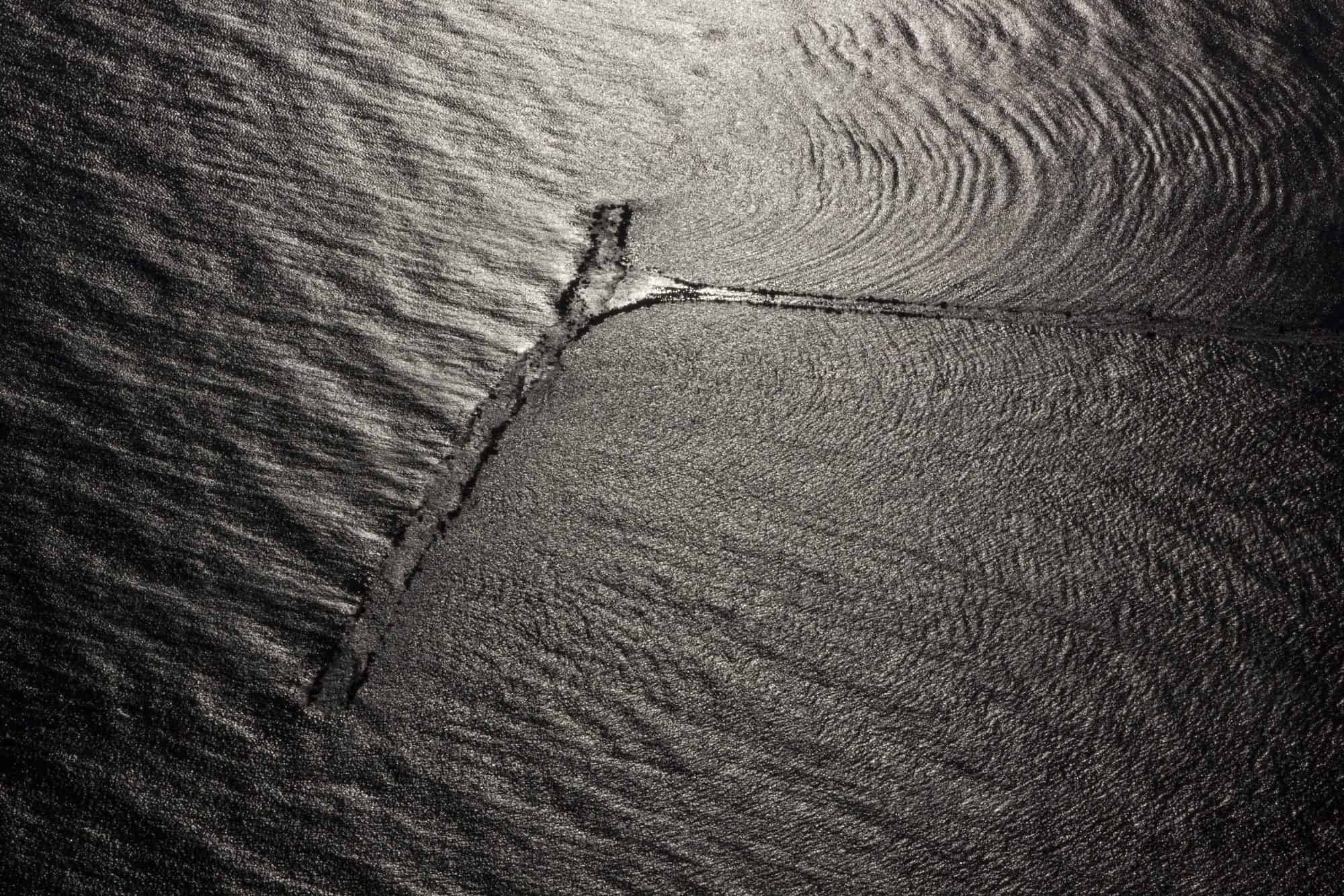
A New Life on the Reef
For years, the eastern beach in Ustka has struggled with the issue of strong sea erosion and shoreline retreat in winter. To keep that from happening, it was decided to apply an innovative solution: an artificial reef was built on the seabed, 200 meters from the beach. It is 850 meters long and consists of stone thresholds located several dozen centimeters below the water surface. The objective of the structure is to stop the destructive activity of the waves. An important element of the reef are the so-called habitat modules – oval, openwork concrete structures, look-alike large colanders. It’s the main point of observation of biologists. The building was entered into service in 2016, and already serves as a sanctuary to many species of fish, crustaceans and other marine species. Observing it is like looking at life taking shape “from scratch” in a completely new environment.
Insects


It is by far the richest group of animals in terms of species, as well as the most visually diverse. Although we are not always happy about it, insects are everywhere. However, many of them are useful creatures, additionally pleasing to the eye with their effective external appearance. An excellent example are beetles, including popular carabus coriaceus. They feed mainly on the remains of dead plants, thus cleaning up the places inhabited by them. They can be found in forests and fields, as well as in gardens. The most popular are: the bronze carabid, violet ground beetle, carabus hortensis and the caterpillar hunter – the latter is found in deciduous forests. Coniferous forests are inhabited by species like ribbed pine borer, black longicorn beetle, the Red-brown Longhorn Beetle, Timberman beetle – a bark beetle with incredibly long antennae. One must be cautious on paths as not to step on the dung beetle or the dor beetle. They feed on excrements, and also use those to feed their larvae, which are buried deep underground. The beetle also includes the ladybird, which occurs in several species in this area. A separate group of insects is Hymenoptera, which include, among others ants cleansing the forest. There are mounds of red ants in many places (around Lake Seekenmoor). Hymenoptera are also useful bees and bumblebees as well as wasps, including the German Wasp. There is also the hornet, the bite of which can be potentially threatening, but only for people allergic to insect venom. One of the most beautiful insects are butterflies. There are numerous painted ladies, including red admiral, peacock butterfly and Camberwell beauty, as well as common brimstone. In the vicinity of the Ghost Pond, there is the spectacular scarce fritillary, orange silver-washed fritillary and green-veined white. Here you can also encounter dragonflies, including the Vagrant Darter and the Common Blue Damselfly. On the other hand, the very pond is inhabited by the aquatic diving species, the great diving beetle. On the surface of the water you can occasionally spot swimming the common whirligig beetle, which hunts smaller insects in herds. In turn, drowned individuals are food for common pond skaters who can run on the surface of the water. Of hemipters, the most peculiar thing is the water boatman that swims “upside down”, that is, with the back down. There is also the water stick-insect, which resembles a stick and has a spike at the end of its body, which it uses to apply toxic saliva to victims. Other dragonflies are the brown hawker and the blue wing beautiful demoiselle which can be encountered upon Słupia. In turn, the fields and meadows by the river are the kingdom of grasshoppers. Among them the most conspicuous ones are: the long-horned grasshopper and the wart-biter.
AMBER
Amber – the most beautiful souvenir of relaxation by the sea
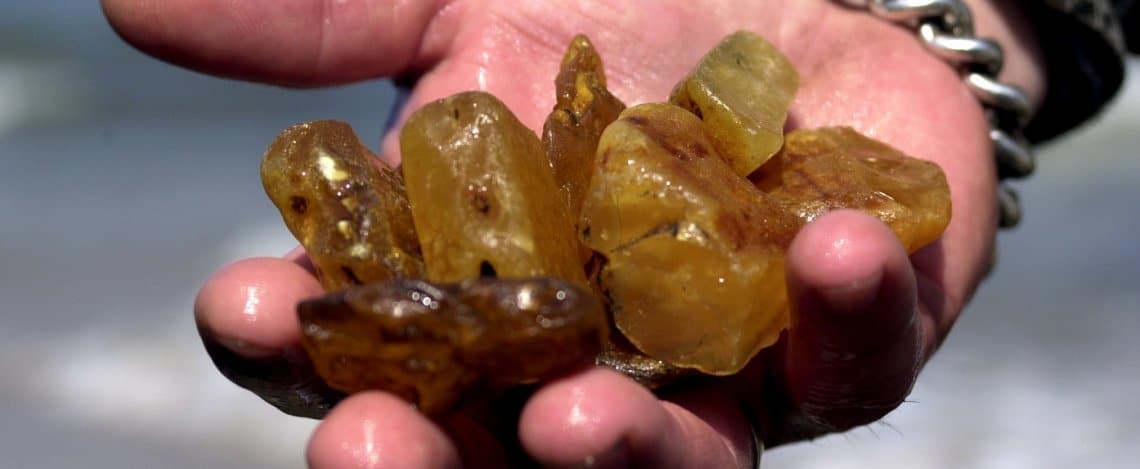
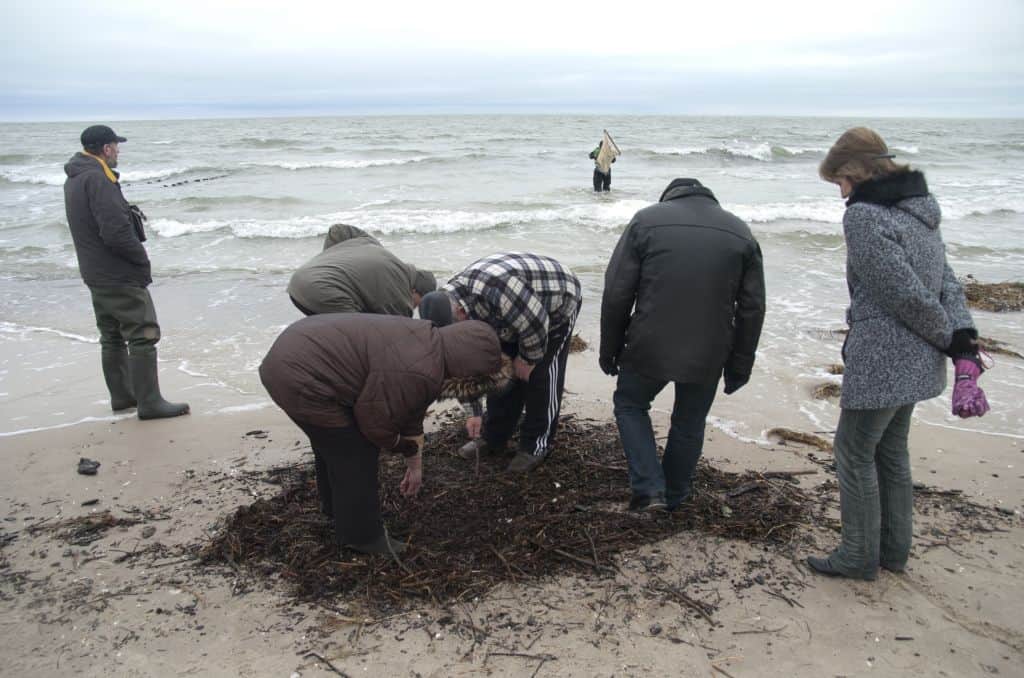
Who among us, walking by the sea, does not dream of finding a beautiful and natural amber stone under our feet? Everyone, of course. That said, most of us believe that it is unrealistic, and only specialized amber fishermen have the chance to find the “gold of the Baltic Sea”. This is not true at all. Each of us have a chance of finding amber stones on the beach. All it takes is a little patience and determination. Below we give you some tips that will help you in your independent search for amber.
Favorite places of amber
First of all, amber has places where it likes to stay. Therefore, on the way to the beach, do not search for amber in sandy places. Amber likes to hide in garbage at the bottom of the sea. The most common are seaweed and water grass thrown ashore by the sea. It is also often hidden among small black pebbles. And so, in your search for amber on the beach, be sure to first look for darker spots on the shore, or in close proximity to the shore.
The magpie method – we only collect trinkets
Let me give you a hint straight away – amber, like every gemstone, shines. However, for amber this is only possible when it’s wet. This would be another way of finding it. Look for stones that will sparkle in the water. This is also important information for those who enjoy walking on the beach after dark. Amber is reflected in the light of the flashlight. It’s very easily detectable on the beach at night.
Swimming gold
Amber is also lighter than other real gems. This means that when we take a handful of stones from the water, the amber will be on top. It might even float. This is one of the oldest methods of searching for amber, which requires only a small vessel. We fill it with some water and coastal sand. We turn the vessel with movements similar to those used by gold diggers in the past. If it contains amber, it will definitely come to the surface.
We verify the find
When we find amber, but we are not entirely sure that it is the stone we have been looking for, we can verify our knowledge on the spot. First, it is worth trying to bite the amber. Real amber will not be as hard as stone. It is, after all, fossilized wood resin. Secondly, amber can be shorty placed over the fire of a match or lighter. With real amber we will feel the smell of resin. There’s nothing left to do but invite you to the Ustka beaches and encourage you to relax and embark on searches of your own.
The Search for Amber – The Tourist Attraction of Ustka
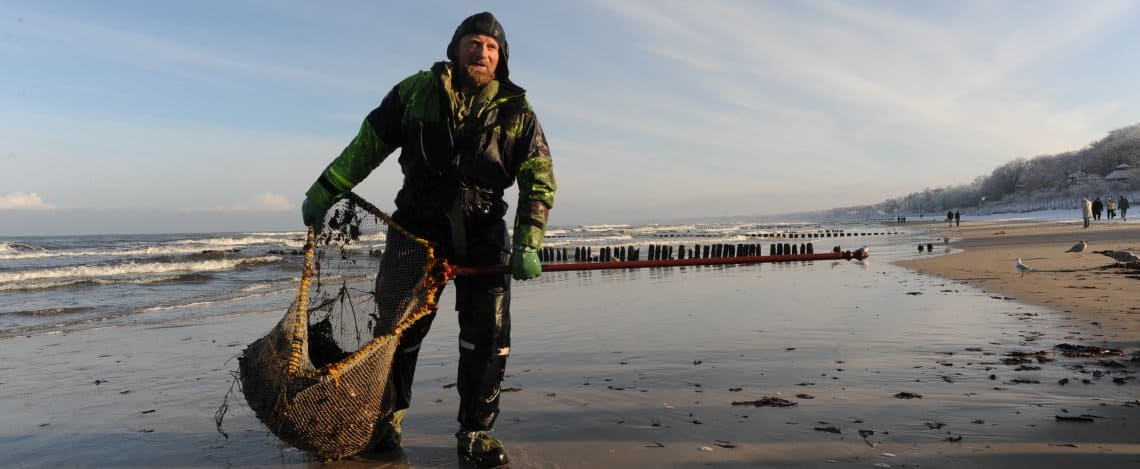
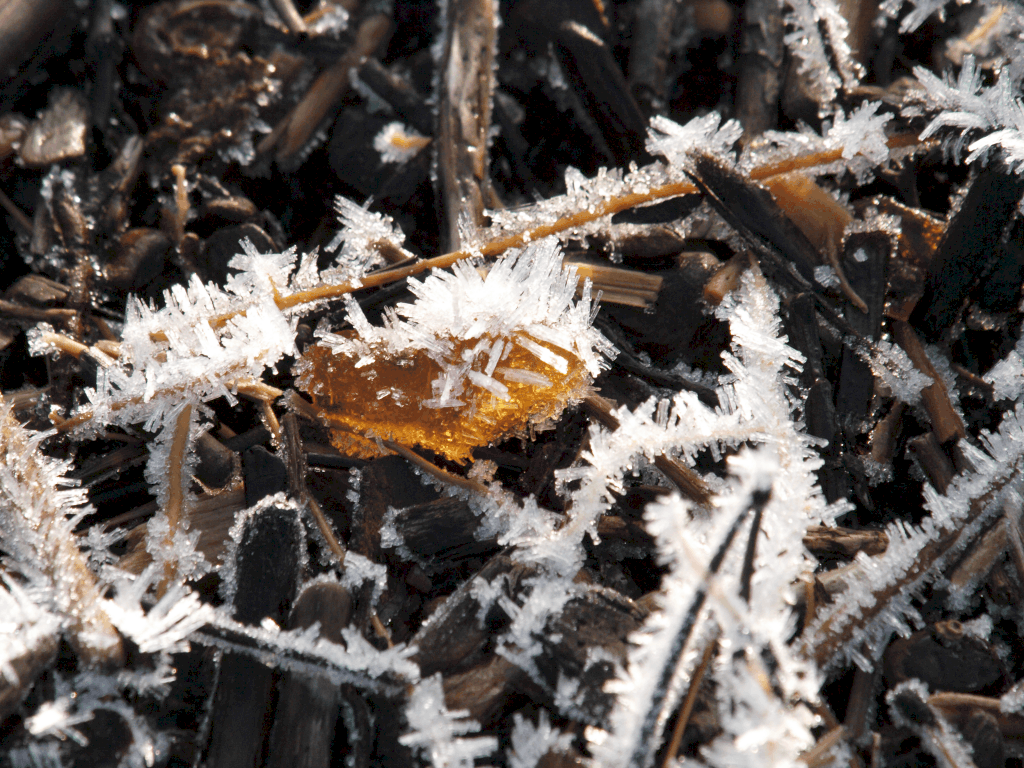
Autumn storms have always attracted thrill seekers to the sea. The stormy sea is not the only magnet attracting people to Ustka. After a storm, people come to the beach in specific clothes; dressed in rubber suits, they step into the water, regardless of the weather. What are people commonly known as amber fishers looking for? Amber, of course. Most of them do it for profit. Unknowingly, however, amber fishers have become a unique tourist attraction in Ustka. Each such seaside spectacle gathers crowds of fans who patiently wait for the results from stepping foot into the water until emptying of the net.
“People are simply curious about what we have in our nets” – says Jerzy Szymeczko, one of the most famous amber fishers in Ustka. First, they are curious to know why we step into the water when it is so cold. But once they find out, they very often even want to help us in our search. Of course, in exchange for a small, original piece of amber. It’s endless curiosity independent of the weather on the beach.
Szymeczko admits that in good weather he is observed by as many as several dozen people. These are most often vacationers relaxing by the sea.
They always ask what we do with the retrieved amber and what it is used for apart from jewelry. They are curious about literally everything. But the best part is, that long after we leave combed rubbish on the beach, enthusiasts of amber are still searching for stones. I admit that they manage to find small pieces sometimes – adds Szymeczko.
Interestingly, amber lovers holidaying at the seaside also try to look for precious stones on their own. Whenever there’s an opportunity, they walk out to the beach and search for amber amongst the litter thrown onto the shore. Patience and determination are always rewarded.
Amber Fishing in Ustka
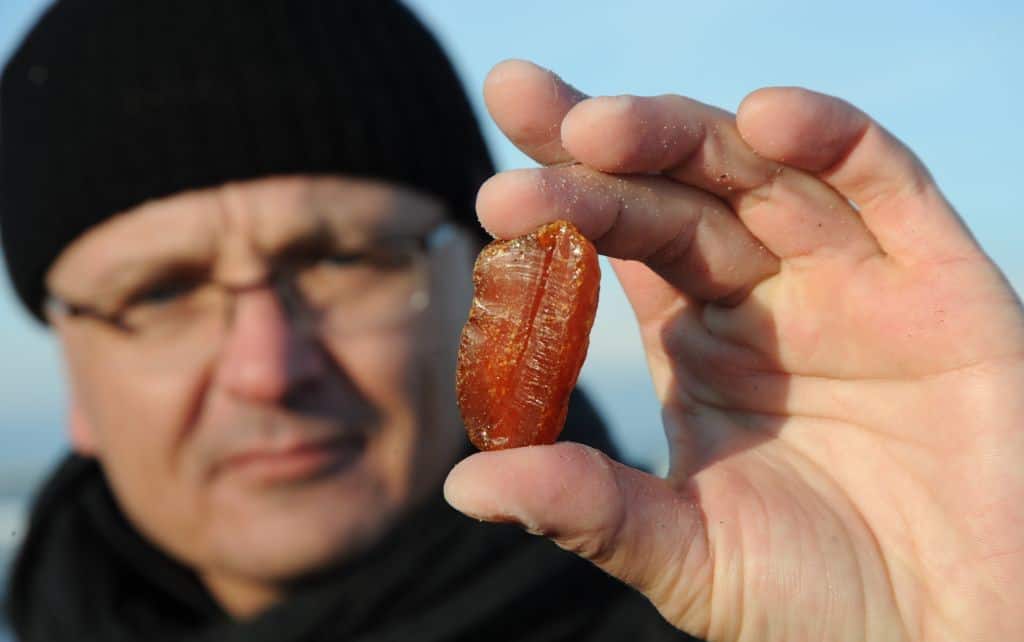
Polish beaches, especially on the central coast, can boast beautiful amber. After the storms, the gold of the Baltic Sea thrown onto the beach attracts countless tourists and real amber fishers, who roam the coastal waters with special landing nets. Amber is a valued mineral that has been used for the production of ornaments for centuries. The combination of amber and silver looks particularly appealing. In many places, tourists can buy products of local jewelers and artists working with amber. Amber also has healing properties – it is used to prepare tinctures from amber sand flooded with alcohol, which can be used for various ailments (headaches, flu, pneumonia and heart diseases). Owing to the rich deposits in the vicinity of Ustka, the city hosts the annual Amber Collecting Polish Championships. The festival which spreads the word about amber and Ustka is the brainchild of Przemysław Nycz, the Ustka councilor. During the event, the organizers throw eighty kilograms of amber and amber products to a designated part of the beach. The task of the contestants is to find as many “amber treasures” as possible in a given time, rinse them in water and give to the commission for weighing. The winner of each category (such as children, women, men, families, journalists and VIPs) receives a cup, and the top three winners are awarded great prizes.
The text is based on the album “Ustka” published by the Region Publishing House on behalf of LOT “Ustka and the Słupsk Land” in 2012.

